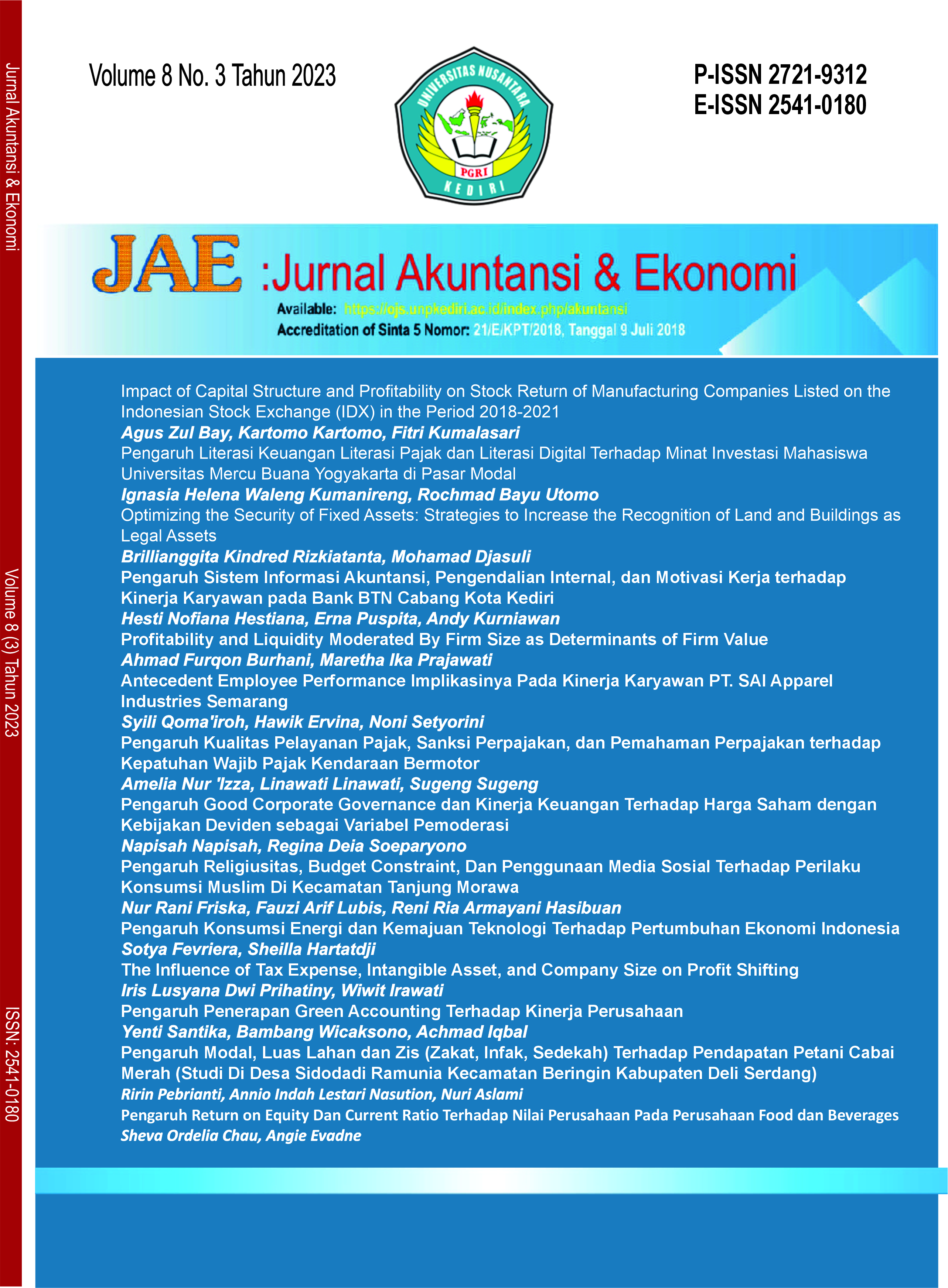Pengaruh Konsumsi Energi dan Kemajuan Teknologi Terhadap Pertumbuhan Ekonomi Indonesia
DOI:
https://doi.org/10.29407/jae.v8i3.19826Keywords:
economic growth; energy consumption; technology advance; gross capital formulation; employment ( 15) to population ratioAbstract
Economic growth describes how economic activities in a country generates additional income for the society in that country in a certain period. Research on the impact of energy and technological progress on Indonesia’s economic growth is relatively limited. The aim of this research is to analyze the impact of energy consumption and technology advance (energy intensity), along with employment (+15) to population ratio and gross capital formulation on Indonesia’s economic growth. Data used in this research is time series data for period 1990-2021 dan analytic technique employed is multiple regression model estimated using ordinary least square (OLS) approach. This research finds that energy consumption has a positive effect and technology advance has a positive effect (energy intensity has a negative effect) on the economic growth. This research also finds that gross capital formulation and employment (+15) to population ratio has no effect on the economic growth.
References
Alfisyahri, N., Syafruddin Karimi, & Ridwan, E. (2020). Hubungan Kausalitas Konsumsi Energi Hydropower, Emisi Karbon Dioksida dan Pertumbuhan Ekonomi pada Negara-negara G20. Jurnal Ilmiah MEA (Manajemen, Ekonomi, Dan Akuntansi, 4(1), 114–127. https://doi.org/10.31955/mea.v4i1.273
Atmaja, B. T., Suhadak, & Hidayat, R. R. (2016). Analisis Pengaruh Timbal Balik Ekspor Impor Minyak Dan Gas Terhadap Pertumbuhan Ekonomi Indonesia (Studi pada Bank Indonesia Periode 2006-2014). Jurnal Administrasi Bisnis (JAB), 31(1), 176–183.
DJKN. (2022). Bauran Energi Baru Terbarukan Ditargetkan 23% di 2025.
Enerdata. (2022a). Energy Intensity.
Enerdata. (2022b). Total Energy Consumption.
Enerdata. (2023). Glossary.
Faisol, Pudjihardjo M, S. D. B. H. A. (2020). Does The Effectiveness of The Government Expenditure Accelerate Economic Growth ? Advances in Economics, Business and Management Research, Volume 144, 144(Afbe 2019), 7–14. https://doi.org/10.2991/aebmr.k.200606.002
Faisol, P. M. D. B. S. H. A. (2018). The Impact of Public Expenditure and Efficiency for Economic Growth in Indonesia. Journal of Applied Economics Sciences, XIII(7), 1992–2003. http://cesmaa.org/Extras/JAESArchive
Fariz, M., & Muljaningsih, S. (2015). Pengaruh Konsumsi Energi Terhadap Pertumbuhan Ekonomi Di Indonesia Periode 1980-2012. Jurnal Ilmiah Mahasiswa FEB Universitas Brawijaya, 3(2).
Fatmawati, I., & Syafitri, W. (2015). Analisis Pertumbuhan Ekonomi Indonesia Dengan Model Solow Dan Model Schumpeter Jurnal Ilmiah. Jurnal Ilmiah Mahasiswa FEB.
Fevriera, S., Archintia, S., & Siwi, V. N. (2022). How Capital, Labor, and technology influence Java’s Economic Growth. Jurnal Ekonomi Pembangunan, 23(2), 269–282. https://doi.org/10.23917/jep.v23i2.18278
Fevriera, S., Bogmans, C., & Mulder, P. (2018). Urbanization versus Renewable Energy Transition in Developing Countries: A Spatial Energy Model and Evidence for Indonesia. Spatial System: Social Integration, Regional Development and Sustainability.
Field, A. (2018). Discovering Statistics Using IBM SPSS Statistics (5th ed.). SAGE Publication.
Gujarati, D. (2015). Econometrics by Example (Second). Palgrave.
Jafari, Y., Othman, J., Hassan, A., & Mohd, S. (2012). Energy Consumption, Economic Growth and Environmental Pollutants in Indonesia. Journal of Policy Modeling, 34(6), 879–889. https://doi.org/10.1016/j.jpolmod.2012.05.020
Mankiw, N. G. (2019). Macroeconomics (Tenth). Worth Publishers.
Mankiw, N. G. (2021). Principles of Economics (Issue February).
McClaude, J. T., Benson, P. G., & Sincich, T. (2022). Statistics for Business and Economics (14 (Global). Pearson.
Mustika, Haryadi, & Hodijah, S. (2015). Pengaruh Ekspor dan Impor Minyak Bumi terhadap Pertumbuhan Ekonomi Indonesia. Jurnal Perspektif Pembiayaan Dan Pembangunan Daerah, 2(3), 107–118. https://doi.org/10.22437/ppd.v2i3.2267
Nugraha, A. T., & Osman, N. H. (2019). CO 2 Emissions , Economic Growth , Energy Consumption , and Household Expenditure for Indonesia : Evidence from Cointegration and Vector Error Correction Model. Internasional Journal of Energy and Policy, 9(April), 291–298. https://doi.org/10.32479/ijeep.7295
Pindyck, R. S., & Rubinfield, D. L. (2018). Microeconomics (Global, 9t). Pearson Education Limited.
Putra, S. N., & Satrianto, A. (2019). Analisis Hubungan Kausalitas Penggunaan Energi, Pertumbuhan Ekonomi dan Emisi Lingkungan di Indonesia. Jurnal Ekonomi Dan Pembangunan, 1(1), 49–68. https://doi.org/10.24036/jkep.v1i1.5349
Ula, T., & Affandi. (2019). Dampak Konsumsi Energi Terbarukan Terhadap Pertumbuhan Ekonomi: Studi di Asia Tenggara. Journal of Economics Science, 5(2), 26–34.
Wahyuni, S., Hamzah, A., & Syahnur, S. (2013). Analisis Pengaruh Teknologi Terhadap Pertumbuhan Ekonomi Provinsi Aceh (Ak Model). Jurnal Ilmu Ekonomi, 1(3), 9.
Wooldridge, J. M. (2020). Introductory Econometrics, A Modern Approach (7th ed.). Cengage.
World Bank. (2022). World Development Indicators.
World Bank. (2023). Employment to Population Ratio, 15+, total (%) (National Estimate). World Bank.
Downloads
Published
Issue
Section
License
Authors who publish with this journal agree to the following terms:
- Copyright on any article is retained by the author(s).
- The author grants the journal, right of first publication with the work simultaneously licensed under a Creative Commons Attribution License that allows others to share the work with an acknowledgment of the work’s authorship and initial publication in this journal.
- Authors are able to enter into separate, additional contractual arrangements for the non-exclusive distribution of the journal’s published version of the work (e.g., post it to an institutional repository or publish it in a book), with an acknowledgment of its initial publication in this journal.
- Authors are permitted and encouraged to post their work online (e.g., in institutional repositories or on their website) prior to and during the submission process, as it can lead to productive exchanges, as well as earlier and greater citation of published work.
- The article and any associated published material is distributed under the Creative Commons Attribution-ShareAlike 4.0 International License







